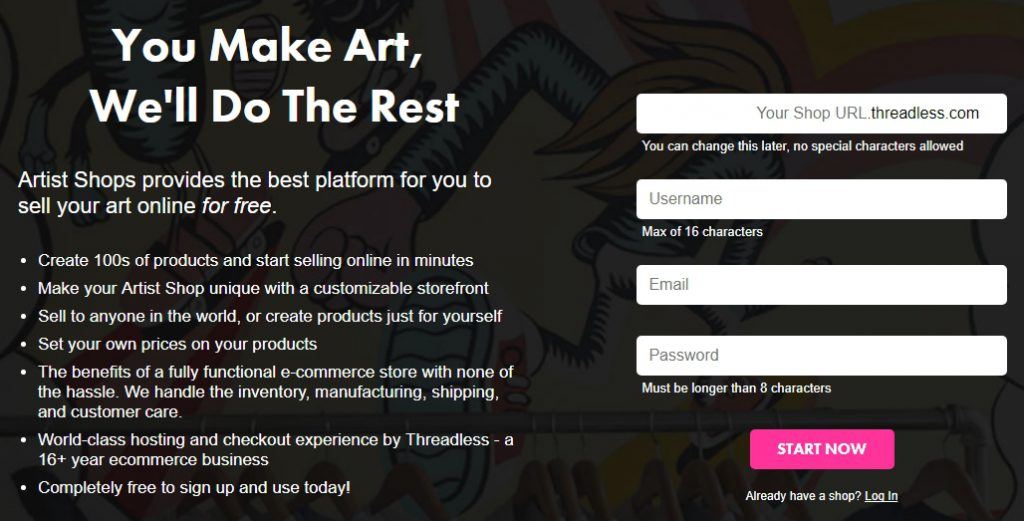
Want to make a fashion statement by printing your designs on T-shirts? Surely you’ve heard of Threadless, a marketplace that helps artists to start their businesses online. It allows sellers to upload original design, match it with certain merchandise before promoting to the shoppers. In this Threadless artist shop review, we’ll find out how to get started and what are the problems to foresee when selling through this type of platform.
How To Earn With an Artist Shop
First, you need to name your shop by creating what we called a subdomain which is free of charge. This means that the shop name will have the Threadless brand name after it. For example,
thisismyshop.threadless.com
In the creator’s dashboard, you can do many things from managing the product page to controlling sales and marketing. The merchandise is provided by Threadless and these are some of the varieties that you can choose from.
- Apparel (women, men, kids)
- Home (pillows, shower curtains)
- Accessories (notebooks, tote bags)
- Wall Art
Each product comes with a “Base Fee”, which covers production and logistics costs. The “Retail Price” is what a shopper pays when purchasing that particular product online. The difference between the two is your earnings.
Retail Price – Base Fee = Your Artist Earnings
By providing a fully functional eCommerce store out of the box, Threadless takes most of the technical hassle in setting up one. Plus, it minimizes your cost of investment because they handle the inventory, shipping, and customer care – not you.

But there’s a caveat to this type of business model and if you want to find success in selling your work online through personal branding, you need to know them.
The Problem With Selling Through Threadless
The simplicity of setting up an artist’s shop on a public platform doesn’t reflect the reality of online selling. For the most part, one doesn’t learn how to do self-promotion online. This is extremely frustrating because many talented designers actually use it, hoping to earn something from their creative work.

The above comment from a new seller clearly demonstrates the lack of online marketing skills, but that’s not entirely his fault. He’s just not exposed to the knowledge.
Firstly, a product page will not magically appear on the search results from a keyword tag. Search engines are smarter now and they can actually read content for keywords and rank (the process that pushes a site to the first page of Google, for example) according to certain metrics.
In between a product page and a blog post, which one do you think to carry more content? Definitely the latter.
More content equals more keywords and search engines will use this as criteria to present information to the users. A product page that only has images and a short description is considered a thin content and they rarely rank by itself if you are relying on organic (natural) traffic alone.
Secondly, it’s pretty obvious that Threadless isn’t going to do any promotion to feature your shop unless you pay them to do so. Even if they do the grunt work for you, you are still faced with massive competitors within a single product category.
For example, in men’s T-shirts alone, there are close to 1000 designs to select from. How do you make your work stand out from the crowd? That’s something important to think about.

Let’s clear some confusion here. When it comes to promoting an online store, your customers need not always be your family or friends. There are 3.2 billion people using the internet and I am pretty sure there’s a tiny fraction of this number that would be interested in your designs.
And no, you aren’t going to beg from strangers. You are going to promote professionally through blogging and there are three advantages to that.
- You can build a brand that’s unique and different from your competitors.
- Blogging means creating more content that the search engine favors.
- Engaging through blogging is like creating a long-term relationship with your customers. It’s good for business.
Depending on what type of designs you want to promote, there are specific keywords that you can use to target an audience that will likely buy as opposed to people who just browse around. When you integrate these keywords into blogging, it’s like having a conversation with your potential customers, sharing your work and getting to know what they want.
In doing so, you aren’t just an art seller, but also an artist with a face and values whose work is worth buying online. Here are some interesting topics that you can write about in an artist’s blog.
- Black and White Bathroom Wall Art
- Autism Awareness T-Shirts for Schools
- What Are Tri-Blend T-Shirts
- Team T-Shirt Design Ideas
- Design Your Own Hoodie for under $20
Marketing, apart from what you are good at, is a vital skill to acquire especially if you are seeking to build a successful business in the online world. It’s what sets you apart from all the others who only dream to be successful, but never really take any action to make it happen.
If you know a little about marketing, you are this much closer to building a sustainable brand, a loyal audience and generally, making more profit. You know your products the best, so why leave the marketing work to someone else, right?
So, Should You Open an Artist Shop?
Having said all that, there’s no harm to creating an artist’s shop. After all, it’s free. The process should be able to give you some basic idea about eCommerce setup and sales tracking. However, if you are new to selling online, don’t expect to be making sales right away.
As mentioned before, you need to participate in your own marketing to see the results. Since Threadless doesn’t provide a blogging platform, you might need to explore other alternatives or integrate a blog to the preexisting shop.
The market for custom design products is huge and if you can find out what’s trending and what consumers are interested in buying on the internet, you could pretty much carve a successful art designing business with or even without your own product. For more tools and training in online marketing, please visit my recommended training platform to learn the step-by-step.
Have any thoughts or questions in regards to the Threadless artist shop review? Kindly leave your comments below and I’ll get back to you.

There are many designs I have made for T-shirts over the years, but I never had the real opportunity to put my work onto actual material. Threadless may be the next platform that I would use for my online store. Blogging definitely could be a great way to market your art shop. There is no better thing for a website than organic, natural traffic.
The Threadless marketplace could be what I am searching for. It’s something that I’ve been considering for a long time. I have a passion for men’s clothing and wanted to start a business by promoting clothes for men online. I also like the idea that they handle the shipping, inventory, and customer care because those can be time consuming and costly.
Regardless, I see that self-marketing primarily through blogging is still one of the recommended ways to attract customers. Will look into your recommended training platform cause my online skills are little to next to none.
Setting up an online business may be pretty easy, but it requires some knowledge on how you should keep the business and market it so that it can be seen worldwide. Having it published means the world could see it but how easy the world could see it is another thing to consider. Owning one of this shop on Threadless is surely an opportunity to consider, but promoting it so that its existence persist is a must too.
Interesting read. I have a few questions:
1) How exactly a person running a Threadless Artist shop makes money?
2) How much does a Threadless Artist shop cost to set up and run?
3) Where can I find out more information about running a Threadless Artist shop?
Hi there David;
1) A person makes money by selling their designs on printed merchandise produced by Threadless. The earning is the difference between the retail price (what customers pay) and the base fee (cost of production).
2) No fee is required to set up the store because your shop basically sits on a subdomain, which is free anyway.
3) You can look up for more information about running an artist shop here.
Hope that helps.
Hello! Glad I came across your review. I started my own digitally illustrated card line several months ago and have been selling on Etsy. However, I’ve been interested in printing my designs on t-shirts, totes, etc. I’ve heard of Threadless but wasn’t sure if it was worth it. It’s good to know that you still have to do all the marketing yourself.
The other thing that worries me is the quality of printing. Have you purchased from Threadless before? Do you know if you can request samples of your work? I’d love to know how the quality is before putting my work up for sale to be printed by someone else.
Hi there Jasmine, according to a friend who has bought a T-shirt from Threadless, the quality is just so-so. I am not sure about sample request, but I think it’s worth ordering an item with your design printed, just to find out what the delivery process and the product quality is like. I’ve heard that TeeSpring has better T-shirts though, so you may want to check on that. Hope this helps.
Just wanted to say thanks for your very insightful article.
You’re right, lots of people get frustrated, because they think the technology platform is going to solve all their business-related issues for them. My view has always been that a new site / blog / sub site is like having a shop in the middle of the desert.
The more marketing you do, the closer your shop gets to the CBD of a big city.
That’s a very relevant metaphor, Ian 🙂